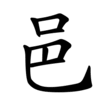邑
| ||||||||
Translingual
| Stroke order | |||
|---|---|---|---|
 | |||
Alternative forms
- 阝 (when used as a right Chinese Radical)
Han character
邑 (radical 163, 邑+0, 7 strokes, cangjie input 口日山 (RAU) or X口日山 (XRAU), four-corner 60717, composition ⿱口巴)
- Kangxi radical #163, ⾢.
Derived characters
- Index:Chinese radical/邑
References
- KangXi: page 1267, character 42
- Dai Kanwa Jiten: character 39269
- Dae Jaweon: page 1767, character 1
- Hanyu Da Zidian: volume 6, page 3753, character 1
- Unihan data for U+9091
Chinese
| simp. and trad. |
邑 | |
|---|---|---|
| variant forms | 阝 radical | |
Glyph origin
| Historical forms of the character 邑 | |||
|---|---|---|---|
| Shang | Western Zhou | Shuowen Jiezi (compiled in Han) | Liushutong (compiled in Ming) |
| Oracle bone script | Bronze inscriptions | Small seal script | Transcribed ancient scripts |
 |
 |
 |
 |
| Characters in the same phonetic series (邑) (Zhengzhang, 2003) | |
|---|---|
| Old Chinese | |
| 唈 | *qɯːb, *qrɯb |
| 浥 | *qrɯːb, *qab, *qrɯb |
| 裛 | *qrab, *qab, *qrɯb |
| 俋 | *r'ɯb |
| 挹 | *qɯb |
| 邑 | *qrɯb |
| 悒 | *qrɯb |
Pronunciation
Definitions
邑
Japanese
Kanji
邑
(“Jinmeiyō” kanji used for names)
- This term needs a translation to English. Please help out and add a translation, then remove the text
{{rfdef}}.
Readings
Etymology 1
Noun
邑 (hiragana ゆう, rōmaji yū, historical hiragana いふ)
- Eup, an administrative division in Korea like a town
Etymology 2
Noun
邑 (hiragana おおざと, rōmaji ōzato, historical hiragana おほざと)
- the "large village" radical, radical 163
Korean
Vietnamese
This article is issued from
Wiktionary.
The text is licensed under Creative
Commons - Attribution - Sharealike.
Additional terms may apply for the media files.